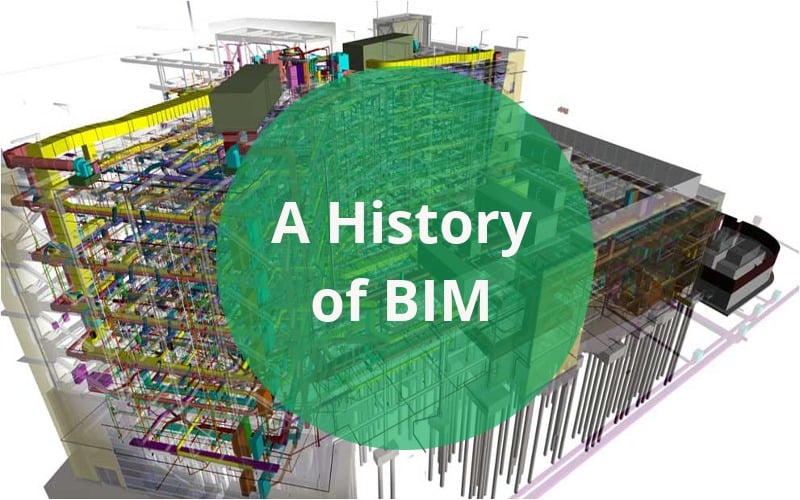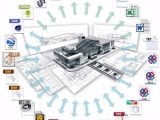Database Building Design
Seeing buildings through the lens of the database contributed to the breakdown of architecture into its constituent components, necessitating a literal taxonomy of a buildings constituent parts. One of the first projects to successfully create a building database was the Building Description System (BDS) which was the first software to describe individual library elements which can be retrieved and added to a model. This program uses a graphical user interface, orthographic and perspective views and a sortable database that allows the user to retrieve information categorically by attributes including material type and supplier. The project was designed by Charles Eastman who was trained as an architect at Berkeley and went on to work in computer science at Carnegie Melon Uniersity. Eastman continues as expert in BIM technology and Professor at the Georgia Tech School of Architecture.
Eastman claims that drawings for construction are inefficient and cause redundancies of one object that is represented at several scales. He also criticizes hardcopy drawings for their tendency to decay over time and fail to represent the building as renovations occur and drawings are not updated. In a moment of prophecy, the notion of automated model review emerges to “check for design regularity” in a 1974 paper.
Eastman concluded that BDS would reduce the cost of design, through ‘drafting and analysis efficiencies’ by more than fifty percent. Eastman’s project was funded by DARPA, the Advanced Research Projects Agency and was written before the age of personal computers, on a PDP-10 computer. Very few architects were ever able to work on the BDS system and its unclear whether any projects were realized using the software. BDS was an experiment that would identify some of the most fundamental problems to be tackled in architectural design over the next fifty years. Eastman’s next project, GLIDE (Graphical Language for Interactive Design) created in 1977 at CMU, exhibited most of the characteristics of a modern BIM platform.
In the early 1980′s there were several systems developed in England that gained traction and were applied to constructed projects. These include GDS, EdCAAD, Cedar, RUCAPS, Sonata and Reflex. The RUCAPS software System developed by GMW Computers in 1986 was the first program to use the concept of temporal phasing of construction processes and was used to assist in the phased construction of Heathrow Airport’s Terminal three (Laiserin – History of BIM). The founding of the Center for Integrated Facility Engineering (CIFE) at Stanford in 1988 by Paul Teicholz marks another landmark in the development of BIM as this created a wellspring of PhD students and industry collaborations to further the development of ‘four-dimensional’ building models with time attributes for construction. This marks an important point where two trends in the development of BIM technology would split and develop over the next two decades. On one side, the development of specialized tools for multiple disciplines to serve the construction industry and improve efficiency in construction. On the other side is the treatment of the BIM model as a prototype that could be tested and simulated against performance criteria.
A later but prominent example of a simulation tool that gave feedback and ‘suggested’ solutions based on a model is the Building Design Advisor, developed at Lawrence Berkeley National Lab beginning in 1993. This software utilizes an object model of a building and its context to perform simulations. This program was one of the first to integrate graphical analysis and simulations to provide information about how the project might perform given alternative conditions regarding the projects orientation, geometry, material properties and building systems. The program also includes basic optimization assistants to make decisions based on a range of criteria which are stored in sets called ‘Solutions’.

Virtual Building
While the developments were happening rapidly in the United States, the Soviet Block had two programming geniuses who would end up defining the BIM market as it is known today. Leonid Raiz and Gábor Bojár would go on to be the respective co-founder and founder of Revit and ArchiCAD. ArchiCAD developed in 1982 in Budapest, Hungary by Gábor Bojár, a physicist who rebelled against the communist government and began a private company. Gábor wrote the initial lines of code by pawning his wife’s jewelry and smuggling Apple Computers through the Iron Curtain (Story). Using similar technology as the Building Description System, the software Radar CH was released in 1984 for the Apple Lisa Operating System. This later became ArchiCAD, which makes ArchiCAD the first BIMsoftware that was made available on a personal computer.
The software was slow to start as Bojár had to struggle with a unfriendly business climate and the limitations of personal computer software, so ArchiCAD was not used on large scale projects until much later. ArchiCAD has made substantial gains in user base from 2007-2011, mainly as a tool for developing residential and small commercial projects in Europe. Recent improvements have made ArchiCAD a major player in the market though fundamental issues such as a lack of a phasing component and a complicated (but flexible) programming environment for its family components using GDL (Geometric Description Language) To date, Graphisoft claims that more than 1,000,000 projects worldwide have been designed using ArchiCAD.
Not long after Graphisoft began to sell the first seats of Radar CH, Parametric Technology Corporation (PTC) was founded in 1985 and released the first version of Pro/ENGINEER in 1988. This is a mechanical CAD program that is utilizes a constraint based parametric modeling engine. Equipped with the knowledge of working on Pro/ENGINEER, Irwin Jungreis and Leonid Raiz split from PTC and started their own software company called Charles River Software in Cambridge, MA.
The two wanted to create an architectural version of the software that could handle more complex projects than ArchiCAD. They hired David Conant as their first employee, who is a trained architect and designed the initial interface which lasted for nine releases. By 2000 the company had developed a program called ‘Revit’, a made up word that is meant to imply revision and speed, which was written in C++ and utilized a parametric change engine, made possible through object oriented programming. In 2002, Autodesk purchased the company and began to heavily promote the software in competition with its own object-based software ‘Architectural Desktop’.
Revit revolutionized the world of Building Information Modeling by creating a platform that utilized a visual programming environment for creating parametric families and allowing for a time attribute to be added to a component to allow a ‘fourth-dimension’ of time to be associated with the building model. This enables contractors to generate construction schedules based on the BIM models and simulate the construction process. One of the earliest projects to use Revit for design and construction scheduling was the Freedom Tower project in Manhattan. This project was completed in a series of separated but linked BIM models which were tied to schedules to provide real-time cost estimation and material quantities. Though the construction schedule of the Freedom Tower has been racked with political issues, improvements in coordination and efficiency on the construction site catalyzed the development of integrated software that could be used to view and interact with architects, engineers and contractors models in overlay simultaneously.
Towards a Collaborative Architecture
There has been a trend towards the compositing of architectural files with those of engineers who create the systems to support them which has become more prevalent within the past seven years as Autodesk has released versions of Revit specifically for Structural and Mechanical engineers. This increased collaboration has had impacts on the larger industry including a movement away from design-bid-build contracts towards integrated project delivery where many disciplines typically work on a mutually accessible set of BIM models that are updated in varying degrees of frequency. A central file takes an object and applies an attribute of ownership so that a user who is working on a given project can view all objects but can only change those that they have checked out of a ‘workset’. This feature released in Revit 6 in 2004, enables large teams of architects and engineers to work on one integrated model, a form of collaborative software. There are now several firms working towards visualization of BIM models in the field using augmented reality.
A broad variety of programs used by architects and engineers makes collaboration difficult. Varying file formats lose fidelity as they move across platforms, especially BIM models as the information is hierarchical and specific. To combat this inefficiency the International Foundation Class (IFC) file format was developed in 1995 and has continued to adapt to allow the exchange of data from one BIM program to another. This effort has been augmented by the development of viewing software such as Navisworks which is solely designed to coordinate across varying file formats. Navisworks allows for data collection, construction simulation and clash detection and is used by most major contractors in the US today.
Following in the footsteps of the Building Design Advisor, simulation programs such as Ecotect, Energy Plus, IES and Green Building Studio allow the BIM model to be imported directly and results to be gathered from simulations. In some cases there are simulations that are built directly into the base software, this method of visualization for design iteration has been introduced to Autodesk’s Vasari, a stand alone beta program similar to the Revit Conceptual Modeling Environment where solar studies and insolation levels can be calculated using weather data similar to the Ecotect package. Autodesk, through their growth and acquisition of a broad variety of software related to BIM have contributed to the expansion of what is possible from analysis of a model. In late November 2012, the development of formit, an application that allows the conceptual beginnings of a BIM model to be started on a mobile device is a leap for the company.
Contemporary Practice and Design Academics
Some have taken a negative stance on BIM and parametrics as they assume so much about the design process and limit any work produced to the user’s knowledge of the program. This can enable a novice designer who has learned how to perform basic commands to become an incredibly prolific producer while a highly educated and experienced architect can be crippled from inexperience with a programs interface or underlying concepts. This creates a potential for a generational break line that becomes more harsh as a new technology gains market parity.
Some BIM platforms that have a small market share but have made big impacts on the world of design include Generative Components (GC), developed by Bentley Systems in 2003. The GC system is focused on parametric flexibility and sculpting geometry and supports NURBS surfaces. The interface hinges on a node-based scripting environment that is similar to Grasshopper to generate forms. Digital Project is a similar program was developed by Gehry Technologies around 2006 based on CATIA, a design program (and one of the first CAD programs) that was developed as an in house project by Dessault systems, a French airplane manufacturer. These two platforms have spawned something of a revolution in design as the power to iterate and transform has resulted in especially complex and provocative architectural forms.
Patrick Schumacher has coined the movement of parametric building models in architecture, specifically those which allow for NURBS surfaces and scripting environments as ‘parametricism’ in his 2008 ‘Parametricist Manifesto’.
“The current stage of advancement within parametricism relates as much to the continuous advancement of the attendant computational design technologies as it is due to the designer’s realization of the unique formal and organizational opportunities that are afforded. Parametricism can only exist via sophisticated parametric techniques. Finally, computationally advanced design techniques like scripting (in Mel-script or Rhino-script) and parametric modeling (with tools like GC or DP) are becoming a pervasive reality. Today it is impossible to compete within the contemporary avant-garde scene without mastering these techniques.”
Since these techniques have become increasingly complex there has become a component of architectural schools which is specified to train in specific software. A student with knowledge of only one type of software platform may well be trained to design according to the biases of the programs that they are using to represent their ideas. Software performs useful tasks by breaking down a procedure into a set of actions that have been explicitly designed by a programmer. The programmer takes an idea of what is commonsense (Sack 14) and simulates a workflow using tools available to them to create an idealized goal. In the case of BIM tools, the building is represented as components including walls, roofs, floors, windows, columns, etc. These components have pre-defined rules or constraints which help them perform their respective tasks.
BIM platforms typically represent walls as objects with layers, these layers are defined in terms of the depth and height of a wall and are extruded along the length of a line. The program then has the ability to calculate the volume of material contained within the wall assembly and to create wall sections and details easily. This type of workflow is based on the existing building stock and common industry standards and therefore a project which is produced in a BIM platform which emphasizes these tools is likely to reinforce existing paradigms rather than develop new ones. Additionally, the programmers who worked on the early BIM platforms often did not have a background in architecture but employed hybrid architect/programmers who contributed to the development of the programs. One notable exception I have found to this is the work of Charles Eastman who received a Masters of Architecture from Berkeley before working on the Building Description System. The roots of the major BIM platforms that are in use today have been developed by programmers with the peripheral input of hybrid programmer/architects and a global user base who contributes to the development of the software via ‘wish lists’ or online forums where grievances can be aired about a product workflow. The grievances typically result in new features and build upon the existing interface.
Though the general concept and technology behind BIM is approaching its thirtieth anniversary, the industry has only begun to realize the potential benefits of Building Information Models. As we reach a point where a majority of buildings are being crafted digitally, an existing building marketplace where building materials and structural components can be bought and sold locally will emerge. Sustainable design practices reinforce an attitude of designing for disassembly and a marketplace of these parts is essential. Trends in Human Computer Interaction, Augmented Reality, Cloud Computing, Generative Design and Virtual Design and Construction continue to rapidly influence the development of BIM. Looking back at the past it is easier to realize that the present moment is an exciting time for designers and programmers in this evolving industry.









